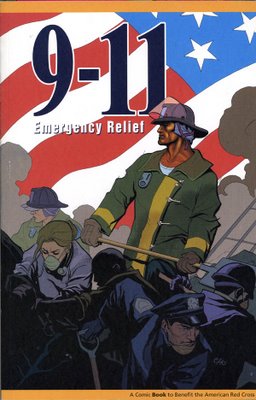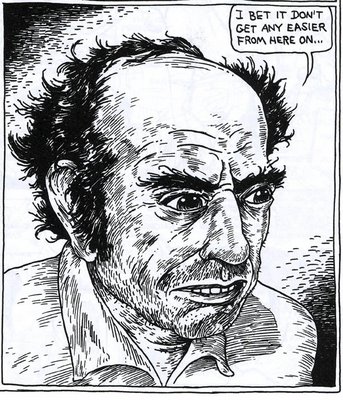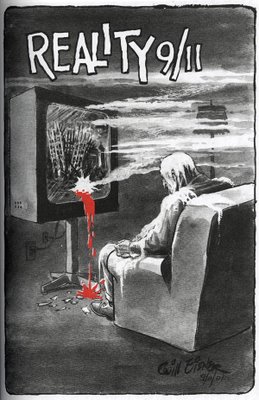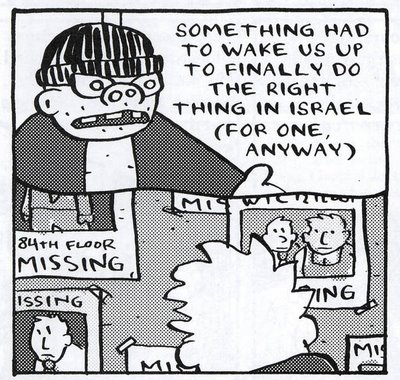
Emergency Relief (128 pages, black and white)
The majority of the contributions in this fourth anthology are autobiographical, a style that has become so familiar in alternative comics. And while this is normally a style I enjoy, in this particular case the stories tended to run together a little. Most contributions tend to follow the same formula - the artist learns about the terrorist attacks to which they react with varying degrees of shock, horror, anger or some other similar reaction, and finally conclude with some commentary about the future. Of course the details of each story vary, and some are more successful than others. That is not to say that it is without highlights, as there are clearly some strong pieces here, many of which I cover below, but on the whole, this is probably the weakest of the four 9/11 anthologies.
 Harvey Pekar's single page contribution is little more than an offhand comment, yet it's the perfect opening to this book. His simple statement hits the nail on the head, and as usual, Pekar's everyman voice comes through strongly. Tony Millionaire's portrait of Pekar is perhaps the greatest illustration of the curmudgeonly writer to date, capturing his cynical intensity perfectly.
Harvey Pekar's single page contribution is little more than an offhand comment, yet it's the perfect opening to this book. His simple statement hits the nail on the head, and as usual, Pekar's everyman voice comes through strongly. Tony Millionaire's portrait of Pekar is perhaps the greatest illustration of the curmudgeonly writer to date, capturing his cynical intensity perfectly. What an image by the patron of the comics industry! The red blood literally pouring from the television set onto the graywash floor is literally the only color in this anthology (besides Frank Cho's cover above) and is without a doubt the most powerful single image of any in the four anthologies.
What an image by the patron of the comics industry! The red blood literally pouring from the television set onto the graywash floor is literally the only color in this anthology (besides Frank Cho's cover above) and is without a doubt the most powerful single image of any in the four anthologies. Joe "Beans" Hasting's panel of a television literally screaming at him is an image I really liked. It felt like that at times, particularly as the weeks wore on and the round the clock coverage continued.
Joe "Beans" Hasting's panel of a television literally screaming at him is an image I really liked. It felt like that at times, particularly as the weeks wore on and the round the clock coverage continued. Dean Haspiel's contribution follows the same formula, but features much stronger illustrations than the majority of the others, and is also more immediate due to Dino's proximity to the world trade center.
Dean Haspiel's contribution follows the same formula, but features much stronger illustrations than the majority of the others, and is also more immediate due to Dino's proximity to the world trade center. One of the few artists to deviate from the norm, Tom Hart's four-pager is a multi-layered political commentary on the implications of the attacks, and looking back after five years, it's interesting how accurate some of his predictions turned out to be. Hart also conveys his emotional reaction using a clever split-panel technique which features his familiar narrator in one half while a nameless character wanders around post-9/11 Manhattan in the other.
One of the few artists to deviate from the norm, Tom Hart's four-pager is a multi-layered political commentary on the implications of the attacks, and looking back after five years, it's interesting how accurate some of his predictions turned out to be. Hart also conveys his emotional reaction using a clever split-panel technique which features his familiar narrator in one half while a nameless character wanders around post-9/11 Manhattan in the other.

No comments:
Post a Comment